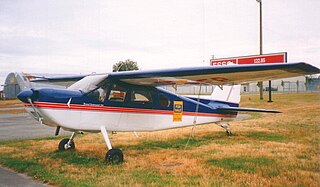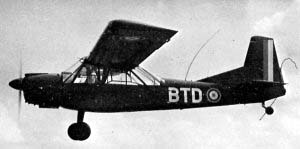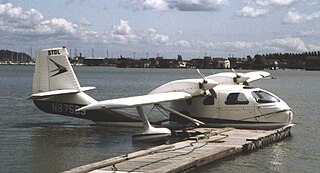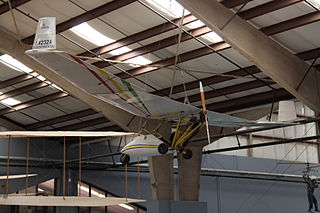
The Globe GC-1 Swift, also known as the Globe/Temco Swift, is a light, two-seat sport monoplane from the post-World War II period.

The Gulfstream American GA-7 Cougar is an American all-metal, 4-seat, twin-engined light aircraft. The Cougar was a twin-engine development of the Gulfstream American AA-5B Tiger and traces its lineage to the AA-1 Yankee Clipper and the Bede BD-1.

The Cessna 340 is a twin piston engine pressurized business aircraft that was manufactured by Cessna.

The Alpha Aviation Alpha 2000 is a two-seat, all-metal training and general aviation aircraft, designed by Chris Heintz and built in Hamilton, New Zealand. It continues the successful French Apex Aircraft's Robin R2000 series acquired upon Apex's purchase of the Avions Robin company.

The Harbin Y-11 is a high wing twin-engine piston utility and geological survey aircraft built by Harbin Aircraft Manufacturing Corporation (HAMC).

The Found Centennial 100 is a Canadian six-seat cabin monoplane produced by Found Brothers Aviation.

The Oberlerchner JOB 15 was an Austrian two-seat light aircraft produced by Josef Oberlerchner Holzindustrie, which had previously designed and built gliders.
The Aviation Industries of Iran AVA-202 is an Iranian two-seat, light aircraft designed as a trainer and sporting aircraft. It was intended for the Iranian domestic market to avoid dependence on imports.

The Goodyear GA-2 Duck was a 1940s American three-seat light amphibious aircraft built by the Goodyear Aircraft Corporation. The design team included David Thurston, who later developed several other light seaplanes including the Colonial Skimmer, Lake Buccaneer, Thurston Teal and Seafire. Only 19 aircraft were built, and these were used only for testing and as demonstrators.

The Robin HR100 is a French four-seat light monoplane, designed by Chris Heintz and built by Avions Pierre Robin as metal-winged version of the Robin DR253 Regent.

The Thurston Teal is a family of two- and four-seat all-aluminium amphibious aircraft designed by David Thurston in the United States and first flown in 1968.
The Fanaero-Chile Chincol was a prototype trainer aircraft developed in Chile in 1955 for air force use. It was a conventional, low-wing cantilever monoplane of mixed construction, with fabric covered wooden wings and tail surfaces. It was fitted with a fixed tailwheel undercarriage and was powered by a single 215 horsepower (160 kW) Continental O-470 air-cooled horizontally-opposed piston engine. The pilot and instructor sat in tandem, and were enclosed under a long canopy. The prototype Chincol made its maiden flight on 14 December 1955. The Chilean Air Force responded positively to the design, and placed an order for 50 machines. However, technical problems significantly delayed manufacture, and the order was cancelled before the aircraft were produced.

The Nardi FN.333 Riviera, later the SIAI-Marchetti FN.333 Riviera, is an Italian luxury touring amphibious aircraft designed and developed by Fratelli Nardi in the 1950s and produced in small numbers by Savoia-Marchetti during the following decade.

The Nord 3400 Norbarbe was a French two-seat observation and casualty-evacuation aircraft built by Nord Aviation for the French Army Light Aviation.

The IAR-827 was an agricultural aircraft built in Romania in the 1970s and 1980s. The penultimate member of the family of designs that began with the IAR-821, it was, like the others, a conventional low-wing monoplane with fixed, tailwheel undercarriage, and shared the all-metal construction of the IAR-826. The prototype flew in 1976, powered by a Lycoming IO-720 engine, but the production examples that followed all had the PZL-3S.

The Spencer Amphibian Air Car is an American light amphibious aircraft. The name was first used in 1940 for a prototype air vehicle that developed into the Republic Seabee. The name was later used by its designer Percival Spencer for a series of homebuilt amphibious aircraft roughly based on the Seabee design.

The United Consultants Twin Bee is an American twin-engined light amphibious aircraft of the 1960s.

The Robin R 3000 is a French single-engined light aircraft designed and built by Avions Robin, which entered production in the 1980s.

The Mitchell Wing B-10 is an American high-wing, open cockpit, single-seat, tailless, ultralight aircraft and motor glider designed by Don Mitchell and based on his Mitchell Wing hang-glider. It has been produced by a variety of companies in the form of kits and plans for amateur construction. It first flew in 1980.

The Lancair 200 and Lancair 235 are a family of American amateur-built aircraft that were designed by Lance Neibauer and produced by his company, Lancair of Redmond, Oregon. The Lancair 200 was initially called the Lancer 200, but the name was changed due to a naming conflict. It was first shown at AirVenture in Oshkosh, Wisconsin in July 1985. Now out of production, when it was available the aircraft was supplied as a kit, for amateur construction.


















